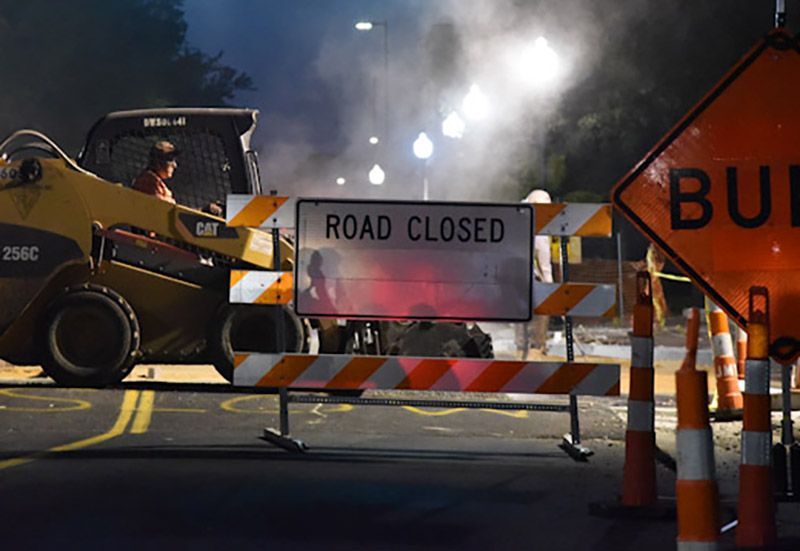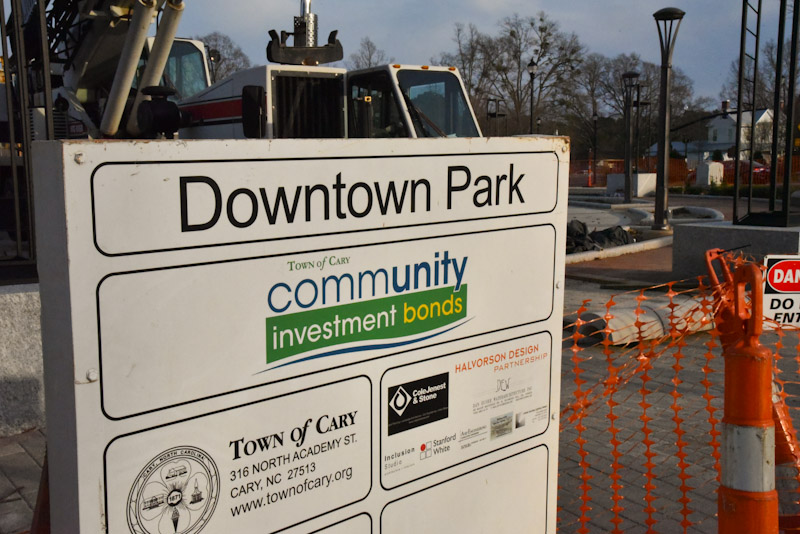Where Does the Money Go in the 2019 Cary Bonds?
Cary, NC – Citizens packed the Cary Theater to hear Town Manager Sean Stegall talk about the proposed Cary bonds and what they will finance, from the Downtown Cary Park to multiple road widenings to preserving open space in town.
The presentation on Cary’s 2019 bond referendum took place Tuesday, September 10, 2019. While Stegall led the presentation, state law prevents him from explicitly advocating for people to vote for the bond in the 2019 election.
“I’m not advocating, but you may notice I lean a certain way,” Stegall said.
The bonds are for $112 million for the Parks, Recreation and Cultural Resources department and $113 million for the Transportation department. And unlike with most bonds, because of Cary’s growth bringing in increased tax revenue already, as well as existing financial management in town, Stegall said taxes will not need to be raised in the coming years if this bond passes.
“It’s money we don’t need right now,” Stegall said. “We’ll only ask for it when we need it.”
Before Stegall talked about the specifics of what this money will fund, he compared Cary to an aging body that now needs more upkeep than before, which means spending more money.
“It took a lot of effort to make Cary Cary. It’s going to take even more to remain Cary,” he said. “If we don’t reinvest in Cary, there will be a result: a less prosperous community.”
For all the prices listed in the presentation, Stegall said they are about 80 percent accurate projections, but the terms of the bonds means they can not spend more than what they are listing.
Transportation
For all of the projects funded by the bond referendum, Stegall said they will have their own individual bonds, each with their own terms.
The transportation portion of the bond funds three road widenings, on Green Level Church Road, O’Kelly Chapel Road and Carpenter Fire Station Road, costing $15.5 million, $9.2 million and $4 million respectively.
The largest single project funded by the transportation bond is $21 million for road infrastructure in the coming Fenton development. There is also $23 million for various state Department of Transportation roads, to bring them up to “the Cary standard” as Stegall described it.
Additionally, there is $14 million for road improvements around Cary, including intersections, $5 million for parking structures in Downtown Cary and $5 million to repair sidewalks, including on Louis Stephens Road and Cary Parkway.
“When we think of sidewalks, we think of someone in a wheelchair,” he said. “For them, that is not a sidewalk, it’s a lifeline.”
During the question period, nearly all questions were about transportation projects. Multiple people asked Stegall about funding for bike lanes and bike-friendly projects. Audience members noted that while cyclists are heavily featured in marketing for the bonds, as well as the referendum’s logo, there are no bike projects listed as part of the bonds.
Stegall said cycling imagery is “aspirational” and the town’s goal is to make roads more bicycle-friendly, but this will require a lot of retrofitting and will take a long time.
“Important things are not done quickly,” he said.
Stegall also said this is a product of cyclists not being a priority for engineers or engineering schools in decades past, but it is a more important piece nowadays.
Stegall was asked about the older neighborhoods that have no sidewalks. Like when Stegall said it now costs more to maintain Cary, the standards and quality of sidewalks now mean that it takes longer and costs more. But, Cary has recently changed the way it funds sidewalk maintenance versus building new sidewalks so Stegall said this should result in more sidewalks in the future.
Parks, Recreation and Cultural Resources
The biggest single project with these bonds is $50 million for the Downtown Cary Park. Stegall said that price comes from the kind of park Cary residents said they wanted in their feedback, and admitted that the town was leaning toward an $80 million design.
The park is important not just as an economic driver for Cary’s downtown, Stegall said, but because to outsiders, it will represent all of Cary.
“When you think of a city, unless you know people who live there, you think of their downtown and that’s where you go to visit,” he said. “We’re going to be judged by the quality of our downtown.”
The bond also funds $20 million in setting land aside for open space, though Stegall noted that more open space in a town means things get more expensive overall.
Other large price tags in the bond are $8.9 million for Carpenter Fire Station Park and $6.1 million for McCrimmon Park in West Cary, as well as $10 million for the not-yet-designed Tryon Road Park. Tryon Road Park is one example of why there are no timelines attached to many of these projects yet – many are several years in the future and whether or not the bond passes will also be a deciding factor.
“I don’t want to say we wouldn’t go ahead with the Downtown Park if the bond didn’t pass, but we would certainly take a pause,” he said. “We’re not taking it for granted that the bond will pass.”
The bond would also fund historic site preservation, improvements at Cary’s tennis parks, skateboard park and greenways and it would create more programming at Veterans Freedom Park.
Election Day in Cary is Tuesday, October 8, 2019. Early voting starts on Wednesday, September 18, 2019 and the deadline to register to vote is Friday, September 13, 2019.
Story by Michael Papich. Photos by the Town of Cary and Hal Goodtree.







If there was an analysis of where the tax dollars are collected and where they are spent, I think we would find that our downtown has benefited by a disproportionate amount. I live near the downtown, so not complaining, but also recognize that I have benefited. Flip side, if the downtown were allowed to fall into further disrepair, Cary as a whole would eventually suffer.
I have lived in Cary since 1977 and watched Cary spend money like the Cary Tennis Park which is near Green Hope High School to practice on. It is a shame that Cary High has to use Dunham Park, , the closest Tennis Courts to them. The problem I see at that park , the courts are so old they the cracks leek water and there are only 5 courts to play . This slows on the playing time when Dunham and other schools come to Cary’s home courts. Cary should be ashamed of themselves for forgetting about our
original park near downtown Cary and the Cary High School and other tennis clubs that use it. I paid taxes since 1977,
but the money goes to all the new areas.
We need money here too.